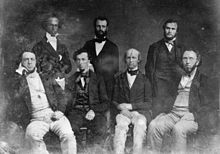New York Daily Tribune
The New York Tribune was one of the leading and most influential newspapers in the United States . It was founded by Horace Greeley (1811–1872) on April 10, 1841 in New York and existed under this name until 1924; It continued to exist under the name New York Herald Tribune until 1966.
The New York Tribune under Horace Greeley (1841–1872)

The Tribune was conceived by Greeley to offer the audience what he believed to be a straightforward, trustworthy source of news and to counterbalance the sensational journalism of the then successful newspapers such as the New York Sun or the New York Herald . Though considered the least vulnerable partisan among the leading newspapers, the Tribune reflected some of Greeley's idealistic views.
After its inception, the New York Tribune quickly became a success and soon had tens of thousands of readers across the United States, also because it was considered the leading journal of the Whig Party in New York City . Greeley was the editor of the newspaper for the rest of his life and used it as a platform for all of his affairs.
The Tribune's success was based on its extensive news stories, its journalists, its feature pages and renowned correspondents such as Ferenc Aurél Pulszky , Karl Marx , Friedrich Engels or Adam Gurowski . Historian Allan Nevins explained the flourishing of the newspaper in his Dictionary of American Biography (1931):
“The Tribune set a new standard in American journalism with its combination of concentrated news, good taste, high moral standards and intellectual standards. Police reports, scandals, dubious medical advertisements, and superficial personal news were banned from their pages, the editorials were pithy but usually moderate, the political reports were the most accurate in town, book reports and excerpts were numerous, and as a die-hard lecturer, Greeley generously gave lectures a wide space. The paper was attractive to solid and thoughtful people. "
When the new Republican Party was founded in 1854, Greeley made the paper its unofficial national organ and fought against slavery . On the eve of the Civil War , the Tribune distributed 300,000 copies nationwide.
Due to the increase in the former European readership on the “new continent” after the revolutionary year of 1848, journalistic contact was sought there. For this purpose, among others, Karl Marx as a London correspondent for the New York Daily Tribune committed. From 1852/53 to 1857 and from 1859 to 1862 Marx worked for the Tribune . When it came to military topics, such as the Crimean War , his close friend and work partner Friedrich Engels wrote the articles for him.
With the support of Jefferson Davis in 1867 Greeleys disgruntled many readers, whereby the Tribune lost about half of its subscribers.
Continuation, renaming and end (1872–1966)
After Greeley died in 1872 and Whitelaw Reid succeeded him, the Tribune became one of the nation's leading Republican dailies. After Reid, his son Ogden Reid took over the newspaper. He took over the New York Herald in 1924 and merged it with the Tribune to form the New York Herald Tribune .
The Herald Tribune developed into the voice of moderate republicanism and was regarded as the epitome of competent journalism for the next four decades. In addition to its typography, the high quality of the articles, the reporting from Washington and abroad, and the political columnists were the outstanding features of the newspaper.
She had some of the best reporters in the newspaper industry with Joseph Fels Barnes , Homer Bigart , Russell Hill , Joseph Driscoll , Joseph Mitchell , Tom Wolfe, and well-respected political columnists such as Walter Lippmann , David Lawrence , Joseph Alsop and Roscoe Drummond . After Ogden Mills Reid's death in 1947, the circulation fell steadily and the newspaper suffered numerous financial setbacks.
In 1961, media entrepreneur John Hay Whitney became majority shareholder, publisher, and editor-in-chief and invested $ 40 million to get the newspaper back on the road to success. Five years later, the Herald Tribune lost its independence. The last edition appeared on April 24, 1966. Together with the also ailing New York newspapers Journal American and World Telegram and the Sun , the Tribune merged to form the World Journal Tribune . But this newspaper was not a good star either. After a lengthy strike, the first edition appeared on September 12, 1966. Almost eight months later, the World Journal Tribune was closed on May 5, 1967.
See also
- New York Tribune Building , former headquarters of the New York Daily Tribune
literature
- Addresses delivered at the presentation exercises on the 13th of May, 1922. Letter in the New York Daily Tribune, 13th May, 1865. Charter. List of officers . Balch Library, Leesburg, Loudoun County, Virginia Ill. 1923
- Manfred Neuhaus , Giesela Neuhaus: Notes on the history of the impact of the "New York Tribune" journalism by Karl Marx and Friedrich Engels . In: Contributions to Marx-Engels Research 3, Berlin 1978, pp. 45–55
- Gisela Neuhaus, Manfred Neuhaus: Karl Marx and Friedrich Engels as foreign correspondents for the most influential progressive bourgeois newspaper on the eve of the North American civil war. On the history of the collaboration of the classics of Marxism at the 'New York Tribune' . in: Marx-Engels-Forschungsberichte 1, Leipzig 1981, pp. 12–62
- Hans-Jürgen Bochinski, Manfred Neuhaus: Marx and Engels and the 'New York Tribune'. On the creation and character of the newspaper as well as the collaboration of Marx and Engels in 1853 . In: Marx-Engels-Jahrbuch 5. Dietz Verlag, Berlin 1982, pp. 215-256
